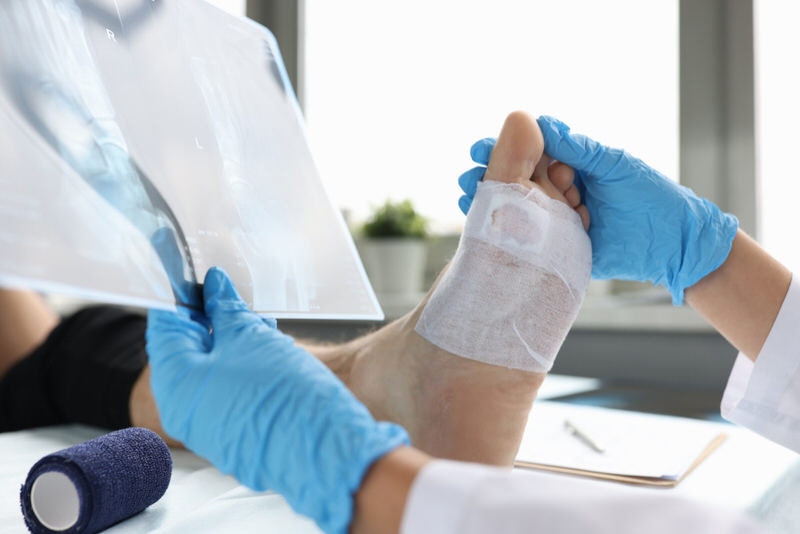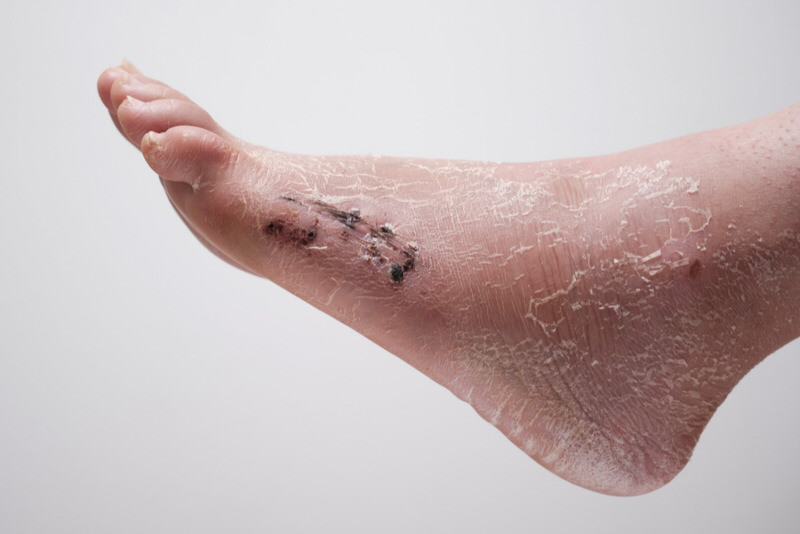If you have undergone foot surgery, you may experience skin peeling. This peeling is normal and occurs due to a process called desquamation. Desquamation is a common occurrence where the outermost layer of the skin (epidermis) undergoes shedding and peels. After you have undergone foot surgery, it is vital to care for your incision properly till it heals. To promote optimal healing, you will have to keep the surgical incision site clean and take proper care of it. In addition, watch for signs of infections, know if your surgical cut is healing the right way, and change your dressing according to your doctor’s instructions.
The bottom of the epidermis makes new skins cells. After the skin cells form in about a month, they push their way up to the topmost layer and, they begin to peel and flake off.
In this way, your skin is constantly making new cells so that it can heal itself. That’s why sometimes new skin cells can be a little tender and delicate in the beginning.
Skin peeling is usually associated with healing and damage due to external factors such as a surgical cut or internal factors such as a rash. Proper aftercare will alleviate pain or discomfort and lower the risk of developing infections and scars.
What causes skin peeling after foot surgery?
Let us explore some causes of skin peeling post-surgery.
1. Dehydration
Surgical wounds need moisture to heal optimally. If our body isn’t getting enough water, the wound healing process gets disrupted.
It will take longer to heal and, the scarring can be more severe.
2. Swelling
Patients develop dry skin and will experience peeling around a surgical area because of swelling.
The skin stretches as the fluid in it builds up. It stretches so much that it brings about separation in the skin cells. It causes them to flake up n separate from each other.
3. Dry climate
If you are developing dry skin all over your body, it could be because you are living in a dry climate area like Arizona or Southern California.
Consider putting a humidifier in your room to reduce the dryness in the air and hydrate and moisture your skin.
4. Dermatitis
Dermatitis is a condition that occurs due to your foot skin coming in contact with any irritants. It could be specific shoes you wear, glues, dyes, and rubber.
If this type of dermatitis is called contact dermatitis and can go away on its own but, if it does not, you must see your podiatrist as soon as possible.
5. Eczema and Psoriasis
Dry skin and peeling along with skin rashes and itching can develop in eczema. It is a form of allergic reaction in which the body’s immune system is attacking the skin. As a result, it causes inflammation in areas like the feet, elbows, face, and hand.
Psoriasis is similar to eczema in appearance but, it occurs due to the skin cells responsible for fighting bacteria.
They start attacking the skin causing a build-up of skin cells in that area. It usually occurs in the elbows, hands, feet, knees, and scalp.
Both these conditions cause dry skin that starts to peel.
6. Cancer
The treatments associated with cancer can affect the skin and the circulation of blood.
The nutrients circulating in the blood are reduced and result in dry and damaged skin that can peel easily. This treatment also delays skin healing time and suppresses the immune system a lot.
How to care for your skin after foot surgery

1. Know what to expect
After foot surgery, your surgeon would have used staples, stitches, glue, or tape strips to seal an incision. It can take anywhere between 6 to 8 weeks for your suture to heal. If you have any medical conditions or taking medication, this may take even longer.
Staples and stitches can be mildly irritating and can cause itching, redness, and swelling. It is because they enter the skin surface and, this is normal.
There can be some liquid that will ooze from the suture out the first few days after surgery and, this is also considered normal.
But if the discharge does not stop after a few days, it is bright red or has pus, you must contact your doctor immediately, as this could be a sign of infection.
If your sutures are held in place with adhesive strips such as steri strips or tissue glue, you need to leave them until the glue disappears on its own or the adhesive strips fall off on their own.
2. Incision care
Ask your doctor how long you will need to keep the surgical area dry. Clean it every day and check for signs of infection. Then, change the dressing as per your doctor’s instructions.
Signs of infection:
- Yellow or green discharge that smells
- Redness
- Increase bleeding or pain
- The skin is hot to the touch
- Change in the size of the incision
- Fever
It is normal for your incision to slowly develop scab over time. It is a good indication of healing as the scab fills the tissue in between the wound.
In addition, it covers the skin underneath to form a protective covering and promote healing.
Do not pick at your scab intentionally or scrub it during a shower.
Instead, wash the area around the stitches with soap as you would wash any other part of the body and rinse well with water.
The incision can take 6 months to even a year to reach its maximum strength and healing. The scabs will fall off in a few weeks and, the skin underneath may be pink or pale. Do not expose this skin to direct sunlight for 3 to 9 months as it can burn easily.
Treatment options
The treatment for skin peeling largely depends on its underlying cause. Skin that peels after surgery is due to the damage to the skin and is a normal process of healing.
- Topical creams or ointments that are available over the counter, prescription medication, and petroleum jelly like vaseline provide adequate relief to itching or redness and promote healing.
- You can opt for cosmetic treatments or procedures that involve retinol/retinoids or benzoyl peroxide to facilitate the healing and bring new skin cells to the outermost layer of your skin.
- Chemical peels or face creams that reduce scarring and wrinkles can also be used to reduce the appearance of scars and treat dry skin.
- Using sunblock is very important for the exposed skin of the scar. Try to cover the area with clothing or socks, if you cannot do that you must wear an SPF 30 or higher to protect the skin from sunburn.
FAQs
What are the symptoms of peeling skin?
The most common symptoms associated with skin peeling are dryness, itching, redness, scaling, and irritation. It can vary depending on the underlying condition that is causing the peeling.
When should you seek medical attention for peeling skin?
You must seek immediate medical attention if you have any of the following abnormal signs and symptoms.
– Swollen lymph nodes
– Shortness of breath
– Hives, rashes, blisters
– Headaches
– Flu-like symptoms
– Joint pain
– Skin swelling
– Unbearable pain
– Fever
What are the complications of peeling skin?
Some complications of peeling skin include bacterial infections and dehydration. Dehydration can occur if large portions of your skin peel off.
Takeaways
After surgery, you are given special instructions to follow for taking care of incisions and your skin. Be sure you follow those as closely as you can, and if you have any questions, call your doctor.
Skin peeling is considered a normal process of skin healing post-surgery. If you have any abnormal signs and symptom symptoms of peeling, as discussed above, you must seek immediate medical help.
Be sure to follow skincare procedures and treatments for the best outcome for your skin post-surgery. As your surgical site heals, do not forget SPF, as it can cause sunburns and bad scarring on the new delicate skin.


